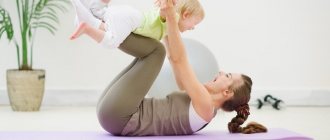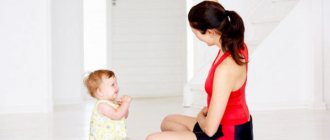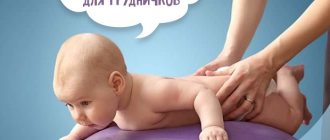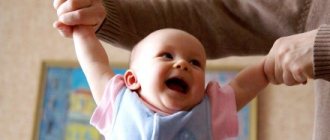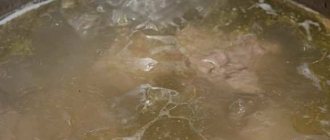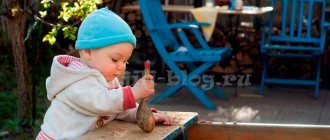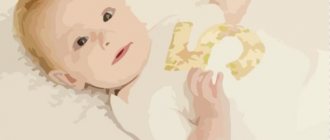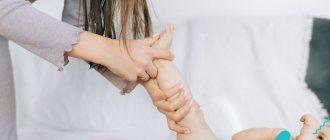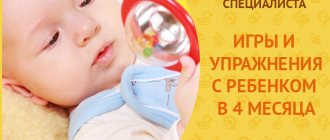Second complex (age 3-4 months)
- Hand massage (stroking).
- Passive crossing of arms over chest.
- Massage of the lower extremities (rubbing, stroking, kneading).
- Back massage (kneading and stroking).
- Active-passive exercise - turn to the right from back to stomach.
- Reflex exercise - swimmer position.
- Massage (rubbing and stroking) the abdomen.
- Massage (patting and rubbing) of the feet.
- Reflex exercises for the feet.
- “Boxing” - passive extension and flexion of the arms.
- Chest massage (vibration).
- Turn left from back to stomach.
For all exercises, the starting position is horizontal.
Third complex (age 4-6 months)
- Crossing arms over chest.
- Foot massage.
- A passive exercise that imitates cycling movements (“sliding steps”).
- Turn to the right from back to tummy.
- Back massage (kneading, stroking, patting).
- Tummy massage.
- Reflex “hovering” on the stomach.
- Raising the torso and head with the support of arms extended to the sides (active exercise).
- Foot massage and exercise for them.
- Extension and bending of the arms or “boxing” (passive exercise).
- Alternate and joint passive extension and flexion of the legs
- Reflex “hovering” on the back.
- Turn left from back to stomach.
- Massage (vibration) of the chest.
All exercises are carried out in the initial horizontal position.
Fourth complex (age 6-10 months).
- Crossing the arms on the chest with support from the rings.
- Alternate and joint flexion of the legs and their extension (so-called “sliding steps”).
- Turn to the right from the back onto the tummy without support from the handle.
- Massage of the tummy, back.
- Crawl.
- Sitting the baby down with support by holding the arms out to the sides.
- Passive raising of straight legs.
- Circular movements with the handles.
- Active exercise - tense arching.
- Turn left from back to tummy.
- Active exercise – raising the body (position on the stomach), supporting the child by straightened arms.
- Sitting down with support by the handles, which are spread shoulder-width apart (active exercise).
All exercises in this complex are performed in a horizontal starting position, with the exception of the “boxing” exercise (at 8 months of age, when the child sits confidently without support, it can be performed in the starting position while sitting).
What kind of massage should I give to my child?
It would seem that everything is clear, if the diagnosis is made - therapeutic massage, if not, then a general classic one. But, like any profession, there are subtleties that children’s massage specialists learn as they gain experience.
In cases of massage for a child due to illness, the following are possible:
- Drainage (for sputum removal) massage is done for a child for pulmonary pathologies: pneumonia, bronchitis. Carried out to improve sputum discharge. This massage is also called percussion (tapping). Lymphatic drainage massage is done for children with obesity and injuries.
- strengthening (tonic) - can be prescribed for hypotonia, delayed motor development, cuts, atony.
- relaxing (sedative) massage for children, can be prescribed for hypertonicity and hyperactive children.
- therapeutic massage for children can include both the above types and acupressure, differentiated, manual correction, exercise therapy, etc.
We mostly have to combine baby massage. The basis is a classic general one, and against its background we add, change the nature of the effect of massage on the child’s body. It all depends on the tasks assigned. (article written for the website happybabymassage.ru, author: massage therapist Alexey Vladimirovich Matrosov)
If you have not received a referral from doctors for a massage for your child, but you want to do it, and you don’t know what massage to give your child, you are tired of endless disagreements on the Internet, just call us 84993941711 or 89266057470, we will listen to you carefully and determine what massage to give your child, and from what month should a child be given a massage. Apply for children's massage services only to professional children's massage therapists and always with a medical education.
Fifth complex (age 10 months – 1 year 2 months)
- Flexion and extension of arms (“boxing”) with rings while standing or sitting.
- "Sliding steps."
- Back massage.
- Turn in one direction or the other from back to stomach.
- Raising the body vertically from a position on the tummy, while the child is supported by the arms.
- Tilt and straightening of the torso.
- Raising the straightened legs to the stick.
- Abdominal massage.
- Sitting down, while supporting the arms spread shoulder-width apart (with a stick).
- Squatting, supporting the child by the arms with rings.
- Tense arching.
- Circular movements with handles with rings.
- Sitting down independently, with the knees fixed, or with the support of the baby by one hand.
Exercises 3, 4,7, 8, 9 are performed in a horizontal starting position. Exercises 10 and 13 are performed according to verbal instructions.
Seventh complex (age 1 year 6 months – 2 years)
- Walking between two sticks, ropes, along the edge of a mat or a chalk path, etc. The width of such a path is gradually narrowed, starting from 30-25 cm and up to 10-5 cm.
- In a lying position on the floor, with the toes of your straight legs, you need to reach for the hoop or from a standing position, take out objects that are lying on the floor, without bending your knees.
- Crawl under a hoop, bench, chair, stick, etc., arching your back.
- Stretch your arms up and, holding a hoop or stick, sit down, and then rise on your toes (“how small and big we are”).
- Roll a pencil, stick, etc. with your foot while sitting on a chair.
- Step over several objects on the floor, the distance between which is 20-30 cm.
Gymnastics should be done every day, every 30-40 minutes. after breakfast, you can also conduct a lesson after the baby sleeps during the daytime. Uniform: T-shirt and shorts. The exercises are performed on the mat barefoot, and you must open the window or transom. The duration of the lesson is 10-12 minutes. For this gymnastics complex you need to have two jump ropes or ropes (length 1-1.5 m), a hoop (diameter 45-50 cm), a stick (diameter 2.5 cm, length 40-50 cm), blocks, cubes, skittles and etc.
Massage for babies at 9-10 months
Higher, and higher, and higher... having mastered the horizontal surface, your baby strives upward - tries to reach the edge of the crib, stand on his feet.
This usually occurs between 9 and 11 months of age. Sometimes there are particularly active young individuals who manage to straighten up to their western height already at 7 months, or imposing couch potatoes who do not want to get up until almost a year old... And this is also the norm, because every baby develops in its own, individual way.
Pediatricians try to time the third course of massage to coincide with the moment when the baby begins to stand up on his own. That is, from 8 to 10 months.
This is an important and difficult stage in a child’s development, so all muscles must be well prepared for the load. Baby massage and gymnastics for a 9-month-old baby differ from massage at 3 months and six months. Let's remember: the purpose of the massage at 3 months was to remove tone, strengthen the cervix, and smooth out the consequences of birth injuries, if any. Umbilical hernia, hip dysplasia, torticollis, clubfoot, adduction of the feet - all these unpleasant features should be tried to be removed as early as possible - during the first two courses of massage.
The second course of massage, which is carried out at approximately 6 months, prepares the baby for crawling and sitting. The emphasis in the massage is on strengthening the back and abdominal muscles. The exercises also correspond to the assigned tasks.
To successfully master verticalization—get up and walk—the baby must have strong leg muscles. The abs, gluteal muscles, and lower back muscles are involved in the process of maintaining balance. Therefore, during the massage process for children 9 months old, special attention is paid to them.
It happens that by the age of 9-10 months, for some reason, the tone in the legs does not go away - the toes curl, the feet are placed incorrectly - inward or on the toes. This needs to be dealt with as soon as possible.
Sometimes an orthopedist makes a diagnosis: valgus position of the foot. The baby seems to be deliberately spreading his feet into a ballet position - is it comfortable to walk and stand in this position? The cause of valgus can be the tone of individual muscles, and weakness of the joints, which cannot properly hold the foot under load. All this can be corrected by massage, physical exercise, and properly selected shoes.
If the tone does not go away, then the neurologist may additionally prescribe an electrophoresis procedure. Electrophoresis is done for children both in the clinic and at home. This is a painless procedure for administering medication to the areas that need it. For example, for hip dysplasia, electrophoresis with calcium and phosphorus is done on the upper thighs, closer to the buttocks. Then the joints receive additional microelements and are formed correctly.
The combination of massage and electrophoresis gives good results in the treatment of hypertension, torticollis, and a number of other diseases.
Both the specialist and the mother must take into account the peculiarities of the baby’s psychological development: at the age of 8-10 months, massage can be complicated by the fact that the child will be negatively disposed towards the new person. Children may get scared and cry, and this is normal. After all, now they have learned to clearly distinguish between loved ones and strangers. If the baby is very scared, then the first sessions can be done in the mother’s arms - it’s more familiar and safer. Patience, distracting toys, and the presence of the mother during the massage will help the baby get used to the procedure. And fun exercises on the ball and on the table will help you get a taste for and enjoy physical activity.
Author: Tarusova Natalya
More about baby massage
Cost of baby massage in St. Petersburg
Massage for a child under 1 year old at home, up to 45 minutes – 950 rubles.
Massage for children over 1 year old at home, up to 60 minutes – 1050 rubles.
Children's massage specialists at the Healthy Mood Center:
Natalya Viktorovna Inna Viktorovna
You can sign up for a children's massage by calling 8 (812) 962 25 51 or through the form Sign up for a session
Eighth complex (age 2-3 years)
- Walking along a stick, rope or along a path whose width ranges from 5-10 cm.
- Reach objects lying on the floor without bending your knees.
- Raise your head and, in a lying position, look at the toy, which is lying on a chair or raised to a height of 25-30 cm.
- Step over pencils, sticks, cubes, which are located at a distance of 20-30 cm from each other.
- Climb through a stick, rope, into a hoop, under a bench or chair, while arching your back.
- Lift a pencil lying on the floor with your toes.
Classes are conducted every other day or daily, about half an hour after breakfast or nap. Classes last 12-15 minutes, the child is dressed in a T-shirt and shorts. All exercises are performed on the mat barefoot, while keeping the window or transom open. For classes you need a jump rope or rope, a hoop (diameter 45-50 cm), a stick (length 1-1.5 m, diameter 2.5 cm), ball, cubes, skittles, and blocks.
Gymnastics and massage for children 1, 2, 3 months | Techniques and exercises
Well, let's get started. I want to say right away that if the description of some element of gymnastics seems incomprehensible to you, you can always watch it in more detail in our video.
And one more small note. In order not to embarrass anyone, we took all the photos and videos with the baby in a diaper, but ideally it is recommended to conduct all classes without any clothing, so as not to restrict the baby’s movements.
All presented techniques and exercises of the complex must be repeated 3-5 times.
